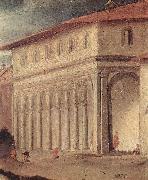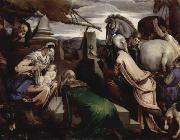Wholesale Oil Painting No Minimum |
|||||||||||
|
|
|||||||||||

|
|||||||||||
|
|
|
||||||||
Giovanni Battista TiepoloItalian Rococo Era Painter, 1696-1770 Giovanni Battista Tiepolo was born in Venice on March 5, 1696. His father, who was part owner of a ship, died when Tiepolo was scarcely a year old, but the family was left in comfortable circumstances. As a youth, he was apprenticed to Gregorio Lazzarini, a mediocre but fashionable painter known for his elaborately theatrical, rather grandiose compositions. Tiepolo soon evolved a more spirited style of his own. By the time he was 20, he had exhibited his work independently, and won plaudits, at an exhibition held at the church of S. Rocco. The next year he became a member of the Fraglia, or painters guild. In 1719 he married Cecilia Guardi, whose brother Francesco was to become famous as a painter of the Venetian scene. They had nine children, among them Giovanni Domenico and Lorenzo Baldassare, who were also painters. In the 1720s Tiepolo carried out many large-scale commissions on the northern Italian mainland. Of these the most important is the cycle of Old Testament scenes done for the patriarch of Aquileia, Daniele Dolfin, in the new Archbishop Palace at Udine. Here Tiepolo abandoned the dark hues that had characterized his early style and turned instead to the bright, sparkling colors that were to make him famous. |
||||||||
|
|
||||||||
Anbetung der Heiligen Drei Konige
Anbetung der Heiligen Drei Konige Painting ID:: 86048 |
Date 1753(1753)
Medium Oil on canvas
Dimensions 425 x 211 cm (167.3 x 83.1 in)
cjr Date 1753(1753) Medium Oil on canvas Dimensions 425 x 211 cm (167.3 x 83.1 in) cjr |
|||||||
|
|
||||||||
Jacopo PontormoItalian 1494-1557 Jacopo Pontormo Galleries Italian painter and draughtsman. He was the leading painter in mid-16th-century Florence and one of the most original and extraordinary of Mannerist artists. His eccentric personality, solitary and slow working habits and capricious attitude towards his patrons are described by Vasari; his own diary, which covers the years 1554-6, further reveals a character with neurotic and secretive aspects. Pontormo enjoyed the protection of the Medici family throughout his career but, unlike Agnolo Bronzino and Giorgio Vasari, did not become court painter. His subjective portrait style did not lend itself to the state portrait. He produced few mythological works and after 1540 devoted himself almost exclusively to religious subjects. His drawings, mainly figure studies in red and black chalk, are among the highest expressions of the great Florentine tradition of draughtsmanship; close to 400 survive, forming arguably the most important body of drawings by a Mannerist painter. His highly personal style was much influenced by Michelangelo, though he also drew on northern art, primarily the prints of Albrecht Derer. |
||||||||
|
|
||||||||
|
|
Anbetung der Heiligen Drei Konige
Anbetung der Heiligen Drei Konige Painting ID:: 91863 |
1519-1520
Medium oil on panel
cjr 1519-1520 Medium oil on panel cjr |
||||||
|
|
||||||||
Jacopo PontormoItalian 1494-1557 Jacopo Pontormo Galleries Italian painter and draughtsman. He was the leading painter in mid-16th-century Florence and one of the most original and extraordinary of Mannerist artists. His eccentric personality, solitary and slow working habits and capricious attitude towards his patrons are described by Vasari; his own diary, which covers the years 1554-6, further reveals a character with neurotic and secretive aspects. Pontormo enjoyed the protection of the Medici family throughout his career but, unlike Agnolo Bronzino and Giorgio Vasari, did not become court painter. His subjective portrait style did not lend itself to the state portrait. He produced few mythological works and after 1540 devoted himself almost exclusively to religious subjects. His drawings, mainly figure studies in red and black chalk, are among the highest expressions of the great Florentine tradition of draughtsmanship; close to 400 survive, forming arguably the most important body of drawings by a Mannerist painter. His highly personal style was much influenced by Michelangelo, though he also drew on northern art, primarily the prints of Albrecht Derer. |
||||||||
|
|
||||||||
|
|
Anbetung der Heiligen Drei Konige
Anbetung der Heiligen Drei Konige Painting ID:: 91864 |
1519-1520
Medium oil on panel
cjr 1519-1520 Medium oil on panel cjr |
||||||
|
|
||||||||
Jacopo BassanoItalian c1510-1592 Jacopo Bassano Gallery He was apprenticed to his father, with whom he collaborated on the Nativity (1528; Valstagna, Vicenza, parish church). In the first half of the 1530s Jacopo trained in Venice with Bonifazio de Pitati, whose influence, with echoes of Titian, is evident in the Flight into Egypt (1534; Bassano del Grappa, Mus. Civ.). He continued to work in the family shop until his fathers death in 1539. His paintings from those years were mainly altarpieces for local churches; many show signs of collaboration. He also worked on public commissions, such as the three canvases on biblical subjects (1535-6; Bassano del Grappa, Mus. Civ.) for the Palazzo Communale, Bassano del Grappa, in which the narrative schemes learnt from Bonifazio are combined with a new naturalism. From 1535 he concentrated on fresco painting, executing, for example, the interior and exterior decoration (1536-7) of S Lucia di Tezze, Vicenza, which demonstrates the maturity of his technique. |
||||||||
|
|
||||||||
|
|
Anbetung der Heiligen Drei Konige
Anbetung der Heiligen Drei Konige Painting ID:: 95750 |
1562(1562)
Medium oil on canvas
Dimensions Deutsch: 92,3 x 117,5 cm
cyf 1562(1562) Medium oil on canvas Dimensions Deutsch: 92,3 x 117,5 cm cyf |
||||||
|
|
||||||||
|
Jacopo Bassano Italian c1510-1592 Jacopo Bassano Gallery He was apprenticed to his father, with whom he collaborated on the Nativity (1528; Valstagna, Vicenza, parish church). In the first half of the 1530s Jacopo trained in Venice with Bonifazio de Pitati, whose influence, with echoes of Titian, is evident in the Flight into Egypt (1534; Bassano del Grappa, Mus. Civ.). He continued to work in the family shop until his fathers death in 1539. His paintings from those years were mainly altarpieces for local churches; many show signs of collaboration. He also worked on public commissions, such as the three canvases on biblical subjects (1535-6; Bassano del Grappa, Mus. Civ.) for the Palazzo Communale, Bassano del Grappa, in which the narrative schemes learnt from Bonifazio are combined with a new naturalism. From 1535 he concentrated on fresco painting, executing, for example, the interior and exterior decoration (1536-7) of S Lucia di Tezze, Vicenza, which demonstrates the maturity of his technique. Anbetung der Heiligen Drei Konige 1562(1562) Medium oil on canvas Dimensions Deutsch: 92,3 x 117,5 cm cyf |
||||||||
|
|
||||||||
|
Prev Next
|
||||||||
|
|
||||||||
|
Related Paintings to Jacopo Bassano :. |
||||||||
|
|
||||||||
|
CONTACT US |




